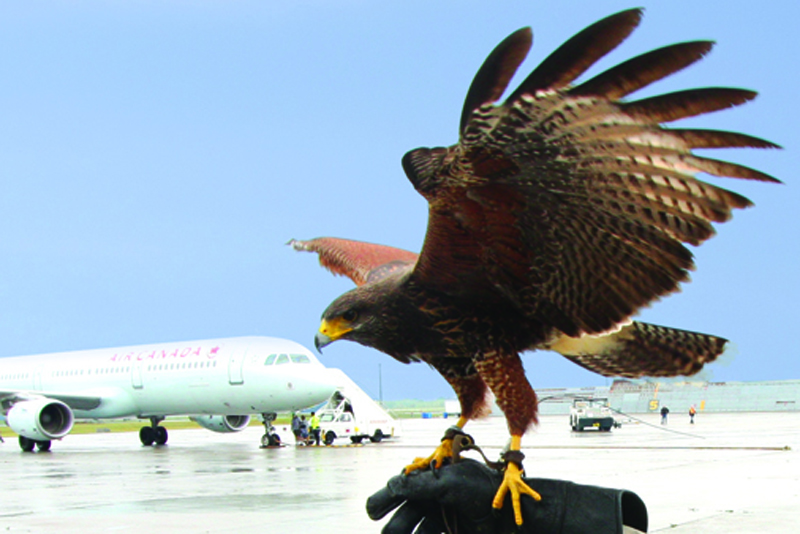
Birds and other wild animals at airports can interfere with air operations and, consequently, pose a safety risk.
To reduce the risk related to wildlife activity within the aerodrome and in its vicinity, ADM relies on teams of wildlife management agents from Falcon Environmental Services (FES), which patrols airport lands from sunrise to sunset, seven days a week. The agents are biologists and wildlife technicians and employ a wide range of methods, including highly ecological ones such as falconry. The team supports the Aéroports de Montréal Fire Service in wildlife management. It includes five agents and five birds (falcons and hawks trained to scare away wild birds).
In compliance with Transport Canada standards and regulations, ADM has a wildlife- management plan, one purpose of which is to reduce the number of wildlife strikes. A strike is deemed to have occurred when a pilot or a ground staff member reports possible contact, even minor, between an aircraft and a bird or other animal, or when animal remains are reported within 60 metres (200 ft) of any surface where aircraft travel. Strikes tend to occur more frequently on landing, when an aircraft is on final approach, than on take-off.
Hazardous species
The ADM wildlife-management plan relies on an inventory of all species living within the airport territory, along with analyses of their characteristics and behaviour. These studies have enabled classification of these species according to the risk they pose, and determination of which ones must be prioritized for management. They include:
-
Canada geese, which are likely to cause more damage because of their size and the fact that they travel in large flocks when migrating;
-
American kestrels, often seen hunting insects above runways.
-
European starlings, ring-billed gulls, as well as cliff swallows are present at the airport, in large flocks and in conjunction with specific events such as heavy rainfall or large concentrations of airborne insects near runways.
-
Coyotes are large mammals that are increasingly abundant on the Island of Montréal and have been present at the airport for several years. Because of their large size, they pose a risk to aircraft, and their populations must be periodically controlled for safety reasons.
-
Though rarely seen on airport land, beavers are monitored because they pose problems for watercourse management and can contribute to the presence of ducks, another high-priority group.
Management methods
The wildlife-management team conducts daily patrols of airport land in vehicles, on foot or by ATV. It studies the behaviour of the birds and animals, and analyzes the stomach contents of dead specimens it finds to learn their food sources and in turn better manage elements that attract those sources. There are two types of approaches used to this end:
1. So-called passive techniques, which involve altering habitats on the airport territory to make them inhospitable to wildlife:
-
Keeping grass at a minimum height of 15 cm, so that insects, worms and micro-mammals cannot be detected by predators;
-
Spreading of species-specific insecticides in problem areas (near runways) at key times of the year before insects reach the adult stage;
-
Camouflaging water-retention pounds with floating balls (called birdballs) to keep waterfowl from landing there;
-
Posters warning personnel and visitors not to feed animals;
-
Anti-perching spikes installed on top of signs and any other structure that can be used as a perch.
2. So-called active techniques, designed to disperse, remove or exclude animals from airport land:
-
Falconry (hunting by falcons or hawks trained to disperse or capture birds), sometimes in association with the canine team;
-
Auditory deterrents (cannons, playback of various species’ distress calls, detonators reproducing gunshots pyrotechnics);
-
Visual repellents (bird carcasses left visible in strategic places to discourage birds of the same species from landing);
-
Olfactory repellents, such as wolf urine;
-
Live capture of birds and mammals using traps, cages or snares, followed by relocation;
-
Capture, relocation and sterilization of eggs of high-risk species.
Lastly, the wildlife-management team is responsible for wildlife-management training and awareness among several airport employees, including firefighters, field teams and members of the Airport Patrol so that they can contribute to enforcing the wildlife-management plan.
Partnerships
Some of ADM’s wildlife-management operations are conducted with outside partners. For example, the City of Montréal supports wildlife-management activity through exchanges of information about certain animal populations on its territory. The Québec Ministry of Forests, Wildlife and Parks is another key partner, issuing required permits as well as coordinating actions related to certain specimens posing risks (e.g., whitetail deer, wild turkey), which are collected and distributed to food banks.



